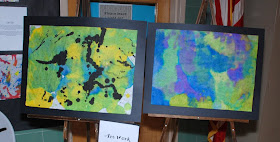
I have always loved the book Cloudy with a Chance of Meatballs and thought this would make a great interdisciplinary lesson to do at my school. I teamed up with one of the really great teachers at my school and started this month long project. She read the book in class and did other lessons that focused on the things that happened in the book and food in general.
I introduced the students to the Pop artist Claus Oldenburg and his giant food sculptures. The students started to get really excited when I told them we would be making our own art based on the book and Oldenburg. For the food sculptures we would make as a class I had pre-made all the armatures out of cardboard and newspaper. We then worked together to cover the bases with strips of newspaper and paper mache paste. This took many days and was very messy, but the students loved to smooth the paper on to the forms. (I swore I would never do paper mache again, but that only lasted three weeks before I was cat it again.) After the food dried we painted each piece to look like real food. We even used colored paper to represent lettuce and cheese on our burger.
In class the students also watched the Movie version of the book and read the sequel, Pickles to Pittsburgh.
I can't wait to display this at the school wide art show this Friday.













































